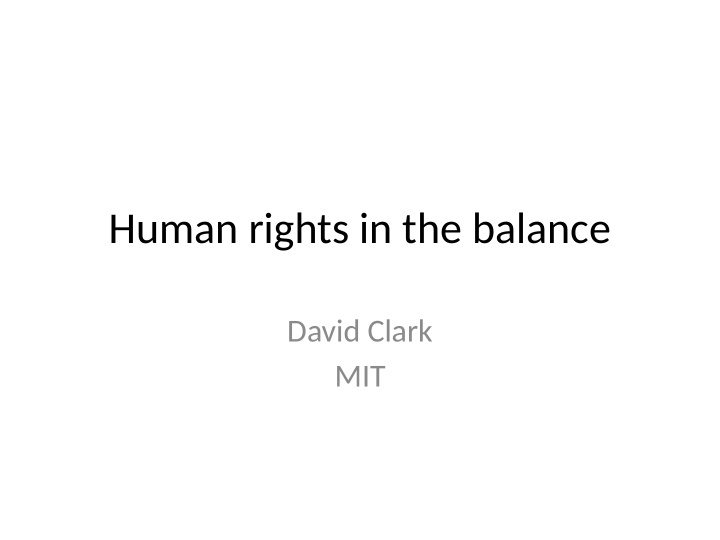



Human rights in the balance David Clark MIT
Why am I here? • I wrote a paper that talked about “tussle”— the contentjon among actors with difgering interests to shape the Internet to their preferences. • Tussle in Cyberspace: Defjning Tomorrow’s Internet IEEE/ACM TRANSACTIONS ON NETWORKING, VOL. 13, NO. 3, JUNE 2005
Managing tussle Architecture and standards can shape tussle but cannot prevent it. We wrote: • Design for tussle — for variatjon in outcome — so that the outcome can be difgerent in difgerent places, and the tussle takes place within the design, not by distortjng or violatjng it. Do not design so as to dictate the outcome. Rigid de- signs will be broken; designs that permit variatjon will fmex under pressure and survive
Informally • You are designing the playing fjeld, not the outcome of the game. • You can tjlt the playing fjeld. • Our work is NOT value-neutral. – I strongly believe in the viewpoints of the “values in design” movement.
Human rights Making the problem harder: rights are not absolute. UDHR Artjcle 29: • In the exercise of his rights and freedoms, everyone shall be subject only to such limitatjons as are determined by law solely for the purpose of securing due recognitjon and respect for the rights and freedoms of others and of meetjng the just requirements of morality, public order and the general welfare in a democratjc society.
Managing tussle • Where does the process of tussle play out? – In the courts and legislature. – In the larger social context of the use of technology. – By the choices about how capital is deployed. – By the use of features of the technology. • Designers of technology have a choice: – To be in the conversatjon or not. • Design the playing fjeld or let the game be played somewhere else.
CALEA An example from the past… • IETF was invited to develop standards for lawful intercept, in the context of the U.S. Communicatjons Assistance for Law Enforcement Act. • The IETF, afuer deliberatjon, declined. – See RFC 2804, from 2000 (See also RFC 1984) – The “RAVEN” process
CALEA 107(a)(2) A telecommunicatjons carrier shall be found to be in compliance with the assistance capability requirements under sectjon 103, and a manufacturer of telecommunicatjons transmission or switching equipment or a provider of telecommunicatjons support services shall be found to be in compliance with sectjon 106, if the carrier, manufacturer, or support service provider is in compliance with publicly available technical requirements or standards adopted by an industry associatjon or standard-settjng organizatjon, or by the Commission under subsectjon (b), to meet the requirements of sectjon 103.
3GPP (SA 3 WG) • [T]he WG will determine the security and privacy requirements for 3GPP systems…. The WG will ensure the availability of any cryptographic algorithms which need to be part of the specifjcatjons. The WG will accommodate, as far as is practjcable, any regional regulatory variatjons in security objectjves and prioritjes for 3GPP partners. The WG will further accommodate, as far as is practjcable, regional regulatory requirements that are related to the processing of personal data and privacy. The subworking group SA WG3-LI will detail the requirements for lawful interceptjon in 3GPP systems, and produce all specifjcatjons needed to meet those requirements.
Human rights in the balance I strongly support the use of human rights as a foundatjonal value in considering design implicatjons. The harder challenge: • Do we design for a preferred outcome and then let the tussle happen in ways over which we perhaps have litule input? • Do we incorporate into our design a tolerance for a range of outcomes, some of which we (as individuals or collectjvely) might not prefer. • Are we clever enough to tjlt the playing fjeld?
Recommend
More recommend